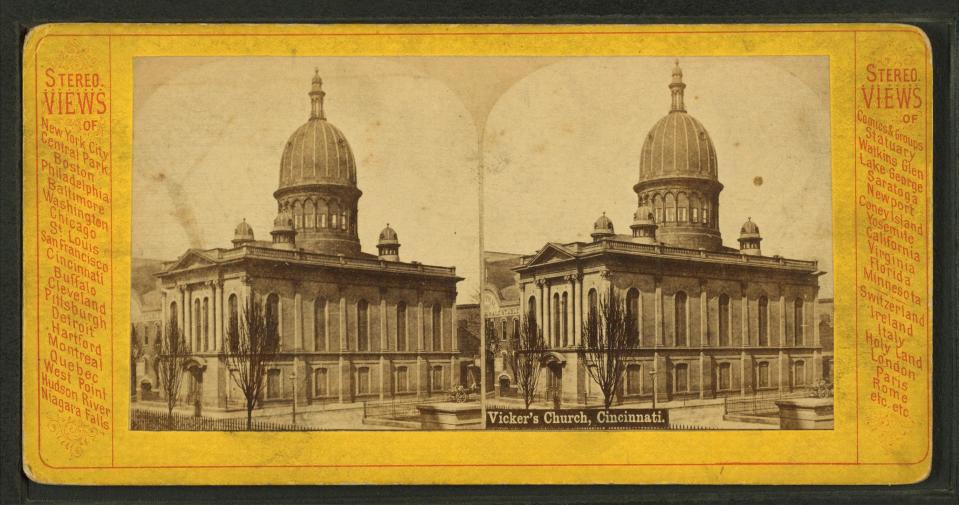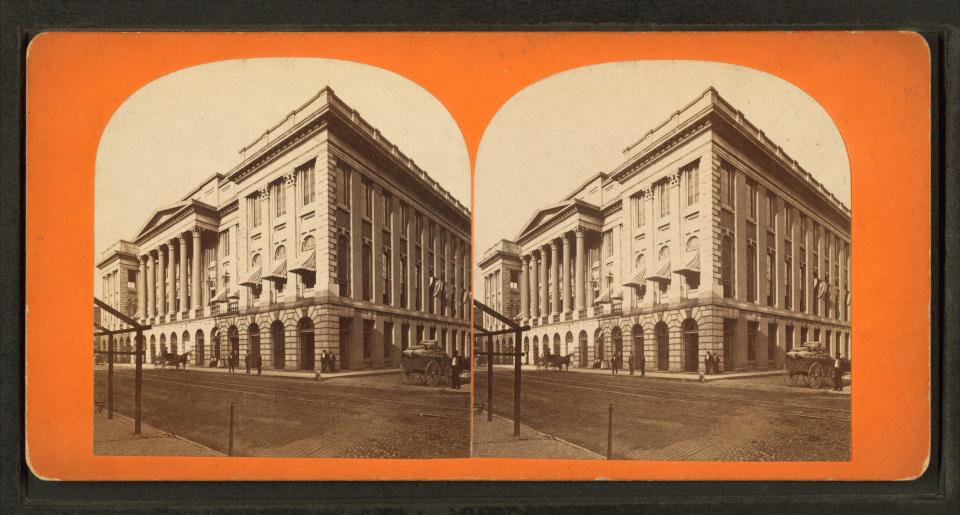1800s Cincinnati comes to life in this collection of rare photos
- Oops!Something went wrong.Please try again later.
Every summer when I was a kid, my brother and I spent a week at my grandparents’ house, mostly hanging out in their finished basement. Among the intriguing knickknacks on the shelves were a covered wagon replica and a decorative cluster of Lucite grapes that looked like large marbles. But I was most fascinated by a weird wooden contraption I later learned was called a stereoscope.
A stereoscope made photographs appear three-dimensional. You could view two slightly different versions of a photograph created from two lenses on a camera, exposed on the same plate. Looking through the prism lenses of the stereoscope simulated the views for the left eye and right eye, which coalesce into a single image with some depth. It was as though you were actually there viewing the scene.
The earliest stereoscopes were invented by Sir Charles Wheatstone, an English scientist, and demonstrated before the Royal College of London in 1838. Oliver Wendell Holmes, the father of the Supreme Court justice of the same name, created a popular handheld model in 1861.
Our history: 31 stellar women in Cincinnati history, from Annie Oakley to Broadway stars
The Holmes version was the one my grandparents had. There was a hooded viewer to look through, and extended on a T-junction about 6 inches away was a stand with wire frames to hold the cards, which were called stereographs.
The 3.5 x 7-inch stereograph cards showed side-by-side images of prominent buildings and parks, what you might find in postcards of the era.
'A surprise such as no painting ever produced'
Stereoscopes were found in nearly every parlor in the late 19th and early 20th centuries. Before movies, even before photographs were commonly published in newspapers or magazines. They were actual photographs, not reproductions in print, and they had surprising detail.
But what made them stand out, even above landscape paintings, was the 3D effect.
Holmes waxed poetic about the wonder of early photography in an essay in The Atlantic, published in 1859. He had particular praise for the stereoscope, which can “produce an appearance of reality which cheats the senses with its seeming truth.”
“The first effect of looking at a good photograph through the stereoscope is a surprise such as no painting ever produced,” Holmes wrote. “The mind feels its way into the very depths of the picture. The scraggy branches of a tree in the foreground run out at us as if they would scratch our eyes out. The elbow of a figure stands forth so as to make us almost uncomfortable.”

My young mind knew a similar device – the View-Master. Those white “reel” discs held dozens of images that also could appear in 3D, scenes of Yosemite or Batman or Mickey Mouse. But those full-color moments felt more like watching a freeze-frame of a movie.
The stereographs were like looking at a freeze-frame of time.
I don’t know what became of my grandparents’ stereoscope. A few years ago, I found the book “New York City in 3D in the Gilded Age,” published by the New-York Historical Society. It was packaged along with a modern-looking collapsible stereoscope and 50 stereograph photos of New York during the 1890s to 1910s.
Through the viewer I could see turn-of-the-century Manhattan. In my mind, I could see my young self discovering a gateway into the past.
All this is preamble for sharing a collection of stereographs I recently found online.
Viewing Cincinnati through a stereograph
The New York Public Library has digital scans of 72,000 stereographic views collected by Robert N. Dennis. In the collection are 97 from Cincinnati.
The stereographs depict Cincinnati scenes, from the Roebling Bridge to Spring Grove Cemetery. They are not dated, but some go back to at least the 1880s.
I was surprised to find photos I had never seen before of the Hamilton County Courthouse from before the infamous riots in 1884. Aside from the well-known photos Louis Rombach and Theodore Groene took of the Ohio National Guard barricading Court Street and the courthouse damage after the fire, all of images of the courthouse I had seen were illustrations.
You will find the Cincinnati stereographic views from the NYPL digital collection at: digitalcollections.nypl.org/collections/robert-n-dennis-collection-of-stereoscopic-views

Take this quiz to test your knowledge of Cincinnati history
This article originally appeared on Cincinnati Enquirer: Rare photo collection shows life in 1800s Cincinnati
